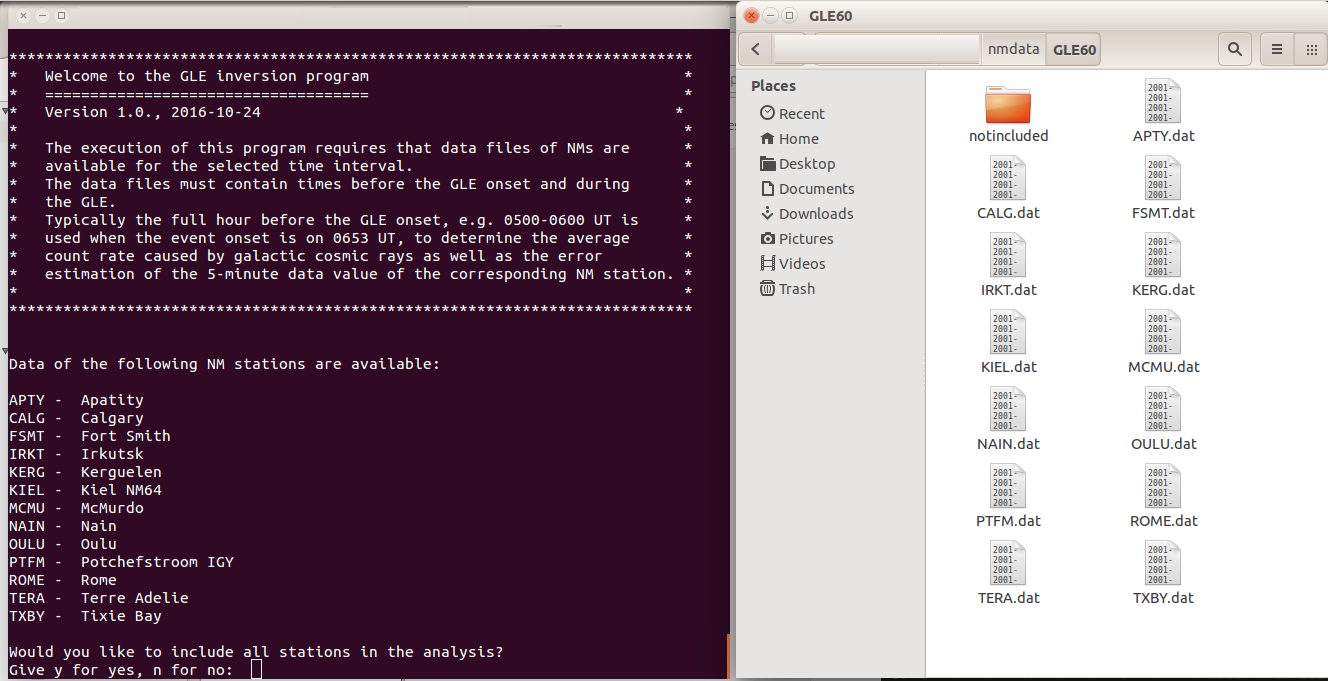How to use the GLE inversion software - Step by step
For a given GLE, e.g. GLE60 (2001 Apr 15), you first need to download the following data:
- Download the 5-min NM data available from NMDB with the program getNMDBdata.py. The time interval, i.e. start and end time, during which the NM data should be downloaded has to be specified in the beginning of the program code. Execute the program by typing pyhton getNMDBdata.py in your terminal. A data file will be generated for each NM station for which data are available in NMDB. The name of the file corresponds to the short name of the corresponding NM station, e.g. KIEL.dat. We encourage the user to copy all the NM data files of one GLE into a subdirectory, e.g. ./nmdata/GLE60/
- Download the OMNI interplanetary magnetic field data from the OMNI database. The website provides annual files of 5-min data in a standard ASCII format named: omni_5minYYYY.asc, e.g. omni_5min2001.asc. It is convenient to copy the needed data file into a subdirectory, e.g. ./omni/
- If not already in your computer, download a .zip file with the asymptotic directions for all NM stations available in the database. Download the data for a given GLE from here and store the files in a convenient folder, e.g. ./asymptotic/
- If not already in your computer, download the Green’s functions of interplanetary transport. These are available in SEPServer as separate files, and also here as a single .zip file. It is convenient to store this data into a separate folder, e.g. ./greens/
Then edit the input file (inparameters.py) for the GLE inversion software and provide the required parameters. Here is an example of the input file for GLE60:

Finally, execute the GLE inversion program GLEinversion.py by typing python GLEinversion.py in the terminal. The program will inform you about the NM data available in the folder you specified in the input file. You can use the data from all these stations or select manually (in the terminal) the ones you would like to consider in your study. Another option is to create a subfolder inside the directory where the NM data are stored and to move the data that you would like to neglect into this subfolder.

The GLE inversion software then reads the asymptotic directions and the OMNI magnetic field data to produce two outputs:
- NMasymptotic.pdf: A plot of the asymptotic directions of the selected NM stations together with the averaged OMNI magnetic field. The asymptotic directions have a time resolution of 15 min and the magnetic field vector has a resolution of 5 min.
- NMpitchangles.pdf: A plot of the pitch angles observed every 5 min by the selected NM stations.
One run of the GLE inversion program may take several minutes. The terminal will inform you about the evolution of the inversion procedure.

The final output of the GLE inversion software includes:
- GLEinversion_results.pdf: A .pdf file containing
- a plot of the goodness of the fit for the values of γ and λ0 tested (the best fit scenario is identified by the minimum value and an open circle),
- a plot of the injection functions inferred for different values of λ0 for the γ-value providing the best fit,
- the NM increases observed by the selected NM stations and the model predictions for the same range of parameters. The best fit case is shown with a thicker line.
- GLEinversion.bestcase: A text file containing information about the stations selected in the fit, the solar wind speed, the values of λ0 and γ that best fit the observations, and the inferred injection profile at the Sun.

 hesperia [dot] info [at] hesperia-space [dot] eu
hesperia [dot] info [at] hesperia-space [dot] eu










